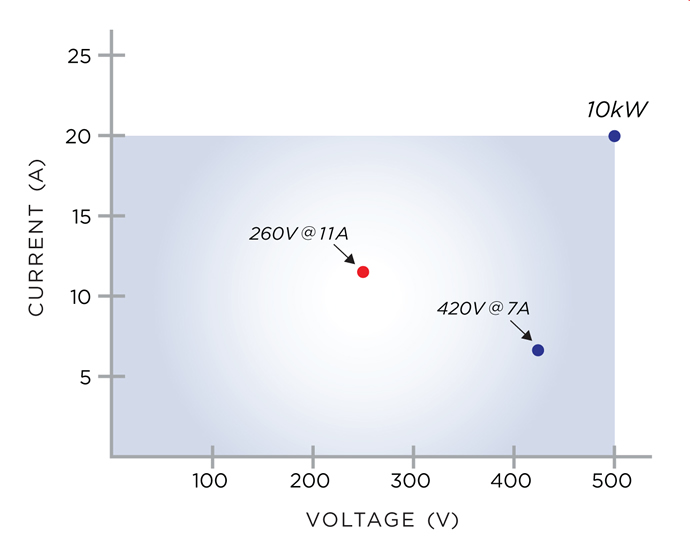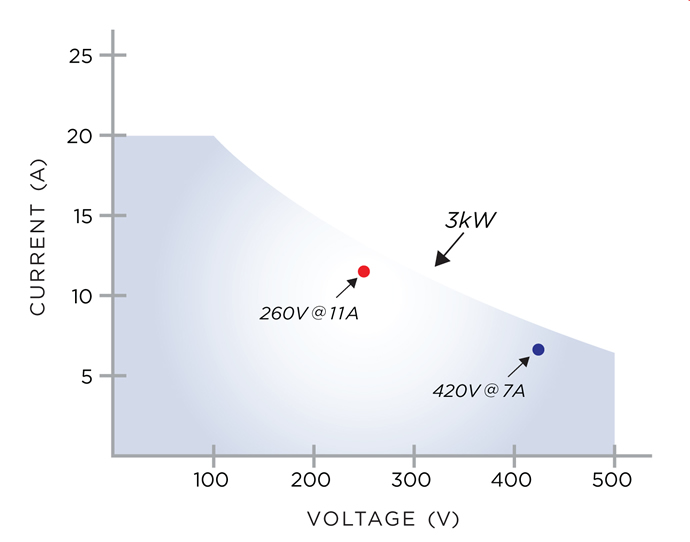The ‘green’ argument for auto-ranging power supplies
Auto-ranging supplies offer the potential to both save equipment costs and save energy. Eric Turner, Intepro Systems.
The term auto-ranging has two very different meanings when it comes to power supplies. Outside of the test and measurement context, auto-ranging is frequently considered as synonymous with wide range, meaning the supply can operate properly over a wide range of input voltage and frequency i.e. 85-240V AC, 50/60Hz. Do a Google search on the term ‘auto-ranging’ and nearly all the information is really about wide range input. That is not what this article is about.
.jpg)
In the parlance of test and measurement applications, auto-ranging refers to the ability of a programmable DC power supply to provide its rated maximum power over a wide range of output voltage and current conditions.
This auto-ranging capability is distinct from the more common ‘rectangular’ power supply. As shown in Figure 1 (above), the rectangular power supply can operate at any voltage/current combination within the limits of the rectangular box. The supply’s power rating is defined by the single point of maximum voltage and maximum current. In contrast, the auto-ranging supply is capable of delivering maximum rated power within a wide envelope of voltage and current combinations, described by the cross-hatched area.
In many, perhaps most, applications, the rectangular power supply is a perfectly acceptable solution. When the device-under-test (DUT) has a limited operating voltage range and/or where the power required is relatively small, the rectangular supply will probably pencil out as the most economical choice.
Auto-ranging power supplies offer benefits in testing of power conversion systems that are designed to operate over a wide range of input conditions. Examples include DC/DC converters, DC motor drives and solar inverters.
DC/DC converter production testing
The following example will serve to demonstrate the benefits of an auto-ranging supply when the product test requires a wide range of input conditions. For the purposes of this example, testing will be conducted on a 2.5 kW DC/DC converter. The DUT has the following specifications:
- Maximum power output: 2,500W.
- Input voltage range: 260V DC - 410V DC.
- Efficiency: 90%.
The specs require this DC/DC converter to deliver a full rated output of 2.5kW over the entire input range. In order to accurately measure the performance, testing must be performed at the operational limits.
The following formula is used to calculate the current that must be available from the programmable DC supply to meet the test conditions:
DC Supply Current, I (in) = DUT Power Output (W) ÷ DC Supply Voltage ÷ DUT Efficiency.
This test could be properly conducted using one of three methods:
- Two rectangular power supplies.
- One larger rectangular power supply.
- One auto-ranging power supply.
Two supply solution
Commercial supplies are readily available at selected power levels. At each power level, the voltage is defined by range with a corresponding maximum current. For example, 5kW programmable DC supplies from a well known supplier are available in over a dozen models including 0-250V@20A, 0-300V@17A, 0-400V@12A and 0-500V@10A.
.jpg)
In order to use standard (rectangular) supplies, each supply must be capable of delivering the required current at the voltage limit condition. To meet the requirement of the test (260V@11A and 410@7A), two 5kW power supplies will be needed (0-300V@17A and 0-500V@ 10A) as shown in Figure 2a (above).
One supply solution
Another approach to this test requirement would be to utilise a single higher rated rectangular power supply that has both test conditions inside the supply’s performance ‘rectangle’. Returning to the catalogue of the same power supply manufacturer, the next higher rated supply to meet the test conditions would be 10kW (0-500V@20A), as shown in figure 2b (below).

Auto-ranging solution
Utilising an auto-ranging programmable DC source, like the Intepro PSI 9000 2U, can handle these same test conditions with a single 3kW device. This unit is designed to provide a full rated output for any combination of voltage (0-500V) times current (0-20A) up to 3kW (see figure 2c) - (below).

Economies, size and energy
Cost: Auto-ranging programmable DC sources are typically ten percent more costly than a similarly rated rectangular supply. However, when you take into account that a lower rated auto-ranger can do the job, this cost differential disappears.
Size: Rack space in a production test set-up can be at a premium. A single rack might be used for several different test set-ups. The two supply solution described here requires two, 3U 5kW supplies. The single supply solution requires just one 3U, 10kW supply. The Intepro auto-ranger requires just 2U of rack height.
Efficiency: Power supply efficiency is typically specified at maximum power output. For example, the rectangular supplies used in the example have an efficiency specification of ‘87% typical at nominal line and max load’. While not published, it is reasonable to assume that the efficiency will be proportionally lower as the actual power output is lower.
So, for the two 5kW supplies operating at roughly half power, the efficiency could be as low as 75%. So at a power output of about at 2.5kW, the power loss would be 625W per unit, or 1,250W for the two supply solution. For the single 10kW unit operating at just 25% of rated output, the efficiency might only be 50%, resulting in the same 1,250W loss.
The efficiency spec for the Intepro auto-ranger is 92%, so the comparable loss would be about 250W. This combination of cost, space and energy savings clearly demonstrate the ‘green’ benefits of auto-ranging in applications where it is applicable.
Auto-ranging is a powerful feature of advanced technology programmable DC supplies, but it’s only the start of the story. Programmable DC supplies need to provide a number of features to meet the requirement of integrated test environments. These include regulated DC output with remote sense; a full range of over voltage, current and temperature protection; comprehensive function generator capability; digital and analogue interfaces for measurement and control; and full front panel functionality.
Beyond the basics, advanced programmable sources will also have programmable functions to simulate specific types of sources e.g. PV arrays, fuel cells, etc.
Summary
Programmable DC sources with auto-ranging output offer advantages over rectangular supplies in applications requiring test over a wide range of input voltage conditions. The units are capable of replacing supplies that take-up test rack space. The units operate closer to their maximum power output so they are typically much more efficient. And an auto-ranging power supply offers the flexibility to handle future needs.







